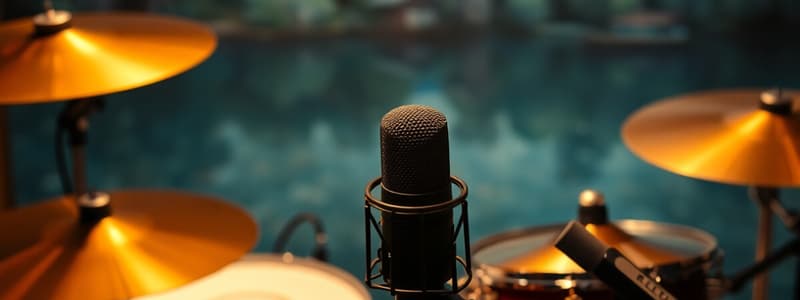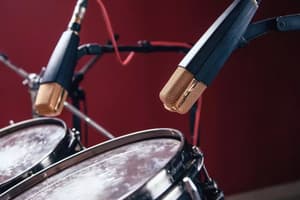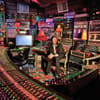Podcast
Questions and Answers
Which microphone is recommended for capturing the 'kick in' drum sound?
Which microphone is recommended for capturing the 'kick in' drum sound?
- Shure SM57
- AKG XLII
- Neumann KM184
- Audix D6 (correct)
What type of microphone is the Neumann KM184, which is used on the hi-hat?
What type of microphone is the Neumann KM184, which is used on the hi-hat?
- Dynamic
- SDC (correct)
- LDC
- Ribbon
Which of the following mics has a super cardioid polar pattern?
Which of the following mics has a super cardioid polar pattern?
- Shure SM57 (snare top)
- Neumann KM184 (hi-hat)
- Shure M X41 8D/S (talk back mic) (correct)
- AKG XLII (crash cymbals)
Which microphone technique is employed for the snare bottom?
Which microphone technique is employed for the snare bottom?
What is the recommended EQ setting for the hi-hat microphone?
What is the recommended EQ setting for the hi-hat microphone?
Which microphone is specified for miking the toms (1,2,3)?
Which microphone is specified for miking the toms (1,2,3)?
For the Sennheiser MD421 on toms, what is the function of the 'M' setting?
For the Sennheiser MD421 on toms, what is the function of the 'M' setting?
For both crash cymbal microphones(left and right), which EQ setting is recommended on the console?
For both crash cymbal microphones(left and right), which EQ setting is recommended on the console?
Which characteristic is specific to the AKG XLII microphone's polar pattern when used for overheads?
Which characteristic is specific to the AKG XLII microphone's polar pattern when used for overheads?
What is a 'shortie boom stand' primarily used for in the context of drum miking?
What is a 'shortie boom stand' primarily used for in the context of drum miking?
What type of microphone is recommended for the 'kick out' drum?
What type of microphone is recommended for the 'kick out' drum?
For the listed drum microphones, which requires 48V phantom power?
For the listed drum microphones, which requires 48V phantom power?
Which model of Shure microphone is used for both the snare top and snare bottom?
Which model of Shure microphone is used for both the snare top and snare bottom?
Which of the following microphones typically requires a 'Latchlake Boom Stand' due to its positioning or application?
Which of the following microphones typically requires a 'Latchlake Boom Stand' due to its positioning or application?
What type of microphone is the Shure M X41 8D/S that is used as the talk back microphone?
What type of microphone is the Shure M X41 8D/S that is used as the talk back microphone?
On the AKG XLII used as overheads, what is the function of the pad?
On the AKG XLII used as overheads, what is the function of the pad?
Which drum mic setup utilizes mics from two different manufacturers?
Which drum mic setup utilizes mics from two different manufacturers?
Which instrument is miked with a microphone that has EQ settings applied on both the console and the microphone itself?
Which instrument is miked with a microphone that has EQ settings applied on both the console and the microphone itself?
For which of the following microphone placements is a pad NOT recommended?
For which of the following microphone placements is a pad NOT recommended?
Which of these microphone placements would most likely make use of a microphone with a large diaphragm?
Which of these microphone placements would most likely make use of a microphone with a large diaphragm?
When positioning a kick-in microphone, what is the primary goal regarding snare bleed?
When positioning a kick-in microphone, what is the primary goal regarding snare bleed?
Why is it important to consult with the drummer about their hi-hat technique when miking the snare?
Why is it important to consult with the drummer about their hi-hat technique when miking the snare?
What is the key reason for miking each cymbal individually?
What is the key reason for miking each cymbal individually?
When using the AKG D12VR on the kick out, what is the primary purpose of the EQ switch?
When using the AKG D12VR on the kick out, what is the primary purpose of the EQ switch?
What is the main advantage of using a cardioid polar pattern for drum microphones?
What is the main advantage of using a cardioid polar pattern for drum microphones?
What is the practical benefit of understanding a microphone's pickup and rejection characteristics when miking drums?
What is the practical benefit of understanding a microphone's pickup and rejection characteristics when miking drums?
How does the proximity effect of a microphone influence its placement on a snare drum?
How does the proximity effect of a microphone influence its placement on a snare drum?
For a drummer who sometimes uses the ride cymbal as a crash cymbal, what adjustment should be made during soundcheck?
For a drummer who sometimes uses the ride cymbal as a crash cymbal, what adjustment should be made during soundcheck?
Why should the bottom snare microphone be positioned away from directly underneath the snare wires?
Why should the bottom snare microphone be positioned away from directly underneath the snare wires?
What is the primary reason for considering the rejection characteristics of a microphone used on the snare drum?
What is the primary reason for considering the rejection characteristics of a microphone used on the snare drum?
Which of the following statements best describes the use of the Shure SM57 on the snare drum?
Which of the following statements best describes the use of the Shure SM57 on the snare drum?
What is the significance of the HPF (High Pass Filter) on the Neumann KM 184?
What is the significance of the HPF (High Pass Filter) on the Neumann KM 184?
When positioning a kick out mic, what is the significance of placing it close to the pedal?
When positioning a kick out mic, what is the significance of placing it close to the pedal?
What does the 'M' stand for on the MD421?
What does the 'M' stand for on the MD421?
What is the purpose of using the 'S' setting on the MD421?
What is the purpose of using the 'S' setting on the MD421?
Considering the AKG 414's sensitivity and pickup pattern, which drum element demands particular attention when using it?
Considering the AKG 414's sensitivity and pickup pattern, which drum element demands particular attention when using it?
What considerations should be made regarding the amount of snare and cymbal bleed when miking a drum kit?
What considerations should be made regarding the amount of snare and cymbal bleed when miking a drum kit?
What should the engineer ask the drummer about regarding the ride cymbal?
What should the engineer ask the drummer about regarding the ride cymbal?
When using the Neumann KM 184, what is the function of the 'M' setting?
When using the Neumann KM 184, what is the function of the 'M' setting?
When using the Neumann KM 184, how do the turns affect the mic?
When using the Neumann KM 184, how do the turns affect the mic?
Flashcards
Kick In Mic
Kick In Mic
Used for the kick drum's inner sound, this mic is dynamic with a cardioid polar pattern.
Kick Out Mic
Kick Out Mic
Also used for the kick drum, this mic is dynamic with a cardioid polar pattern.
Snare Top Mic
Snare Top Mic
Used on the top of the snare drum, this mic is dynamic with a cardioid polar pattern.
Snare Bottom Mic
Snare Bottom Mic
Signup and view all the flashcards
Hi-Hat Mic
Hi-Hat Mic
Signup and view all the flashcards
Tom Mic
Tom Mic
Signup and view all the flashcards
Crash (L) Mic
Crash (L) Mic
Signup and view all the flashcards
Crash (R) Mic
Crash (R) Mic
Signup and view all the flashcards
Ride Mic
Ride Mic
Signup and view all the flashcards
Talk Back Mic
Talk Back Mic
Signup and view all the flashcards
Audio D6 Microphone
Audio D6 Microphone
Signup and view all the flashcards
AKG D12VR Microphone
AKG D12VR Microphone
Signup and view all the flashcards
Shure 57 Microphone
Shure 57 Microphone
Signup and view all the flashcards
Neumann KM 184 Microphone
Neumann KM 184 Microphone
Signup and view all the flashcards
Microphone placement
Microphone placement
Signup and view all the flashcards
Kick In Mic Placement
Kick In Mic Placement
Signup and view all the flashcards
Kick Out Mic Placement
Kick Out Mic Placement
Signup and view all the flashcards
Bottom Snare Mic Placement
Bottom Snare Mic Placement
Signup and view all the flashcards
Hi-Hat Mic Considerations
Hi-Hat Mic Considerations
Signup and view all the flashcards
Cymbal Mic Placement
Cymbal Mic Placement
Signup and view all the flashcards
Ride/Crash Cymbal Level Check
Ride/Crash Cymbal Level Check
Signup and view all the flashcards
Study Notes
Instrument Microphones
- The Audix D6 dynamic microphone with a cardioid polar pattern is used for the kick in drum, good for low end frequencies.
- The AKG D12VR dynamic microphone with a cardioid polar pattern is used for the kick out drum, and requires 48V for EQ switch, but the mic itself does not need 48V.
- The Shure SM57 dynamic microphone with a cardioid polar pattern and pad is used for both the snare top.
- The Shure SM57 dynamic microphone with a cardioid polar pattern and pad is used for the snare bottom, with the phase flipped 180 degrees.
- The Neumann KM184 small diaphragm condenser (SDC) microphone with a cardioid polar pattern is used for the hi-hat, with pad and EQ on console at 200Hz @ -12db shelf; M stands for music, the mic gives all frequencies, every turn gives a HPF up to 5, S is for speech.
- The Sennheiser MD421 dynamic microphone with a cardioid polar pattern is used for the toms (1, 2, 3), including a pad and frequency switch set to "M".
- The AKG XLII large diaphragm condenser (LDC) microphone with a narrow cardioid polar pattern is used for the crash (L), and has a pad with EQ on console at 200Hz @ -12db shelf, as well as pad on the mic at -6dB and HPF at 160 Hz.
- The AKG XLII large diaphragm condenser (LDC) microphone with a narrow cardioid polar pattern is used for the crash (R), and has a pad with EQ on console at 200Hz @ -12db shelf, as well as pad on the mic at -6dB and HPF at 160 Hz.
- The Neumann KM184 small diaphragm condenser (SDC) microphone with a cardioid polar pattern is used for the ride, including a pad and EQ on console at 200Hz @ -12db shelf.
- The Shure M X41 8D/S small diaphragm condenser (SDC) microphone with a super cardioid polar pattern is used for the talk back mic.
Miking Drums - Considerations
- Pickup and rejection are key factors to consider when miking drums.
- Snare and cymbals are usually the loudest and cause the most bleed.
- Toms are also a factor to consider in terms of bleed.
- The kick in mic inside the kick drum needs to be at an angle that rejects the snare.
- Place the kick out mic on the left side as close to the pedal as possible for rejecting the snare.
- Direct the bottom snare mic towards the middle of the snare head, but not too close or directly underneath the medal strands due to messing up the EQ.
- For the snare, ask the drummer what part of the hi-hat they’re going to hit.
- Mic each cymbal individually for panning, facing the center and rejecting other cymbals.
- Ask if the drummer will use a ride cymbal as a crash; then test the levels when it's used as a ride or crash.
Stands
- Shortie boom stands are used
- Latchlake boom stands are also used
Studying That Suits You
Use AI to generate personalized quizzes and flashcards to suit your learning preferences.





